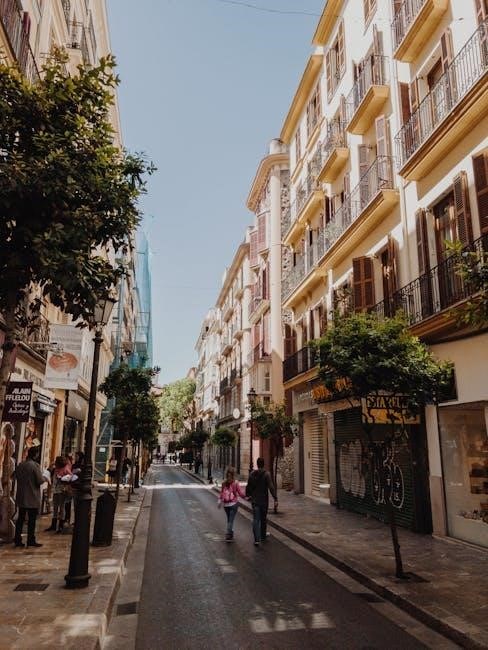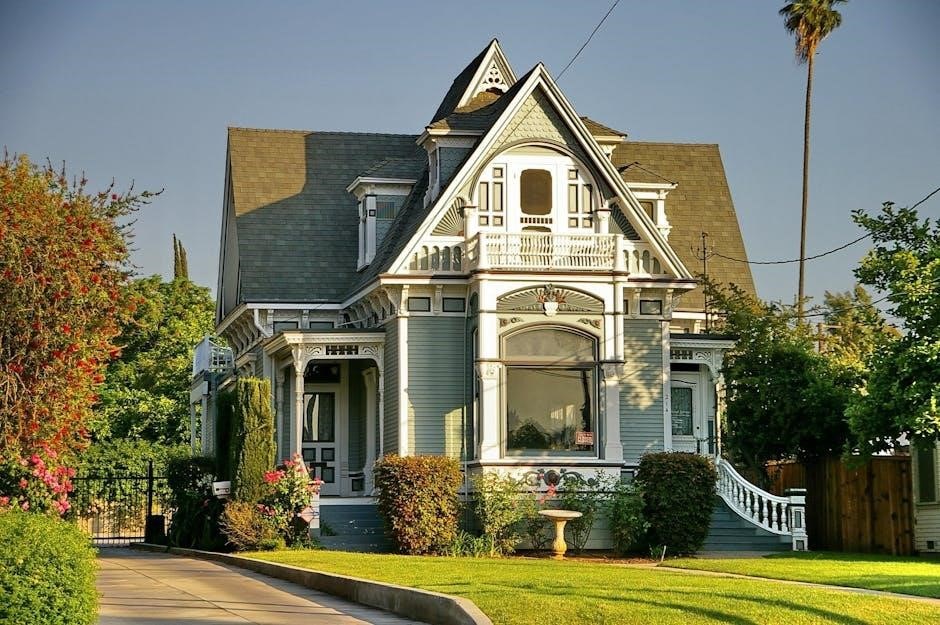pdf of the house on mango street
The House on Mango Street is a poignant coming-of-age novel exploring themes of identity‚ culture‚ and belonging. The PDF version offers easy access to Sandra Cisneros’ vivid storytelling‚ allowing readers to delve into Esperanza’s journey of self-discovery and resilience in a vibrant Chicago neighborhood.
Overview of the Novel
The House on Mango Street is a coming-of-age novel by Sandra Cisneros‚ told through Esperanza’s poetic and intimate voice. It explores themes of identity‚ culture‚ and belonging as Esperanza navigates her life in a Chicago neighborhood. The PDF version of the novel is widely accessible‚ offering readers a convenient way to engage with Esperanza’s journey. It includes study guides and discussion questions‚ making it a valuable resource for both individual readers and educational settings.
Author Sandra Cisneros and Her Background
Sandra Cisneros‚ a Mexican-American writer‚ was born in 1954 in Chicago. Her experiences growing up in a working-class family deeply influenced her work. Cisneros earned an MFA from the Iowa Writers’ Workshop and gained recognition for her unique voice. The House on Mango Street‚ her debut novel‚ reflects her own struggles with identity and culture. The PDF version of her work is widely accessible‚ making her poignant storytelling available to global readers.
Significance of the Title “The House on Mango Street”
The title reflects Esperanza’s longing for a home that represents stability and identity. Mango Street symbolizes both her current reality and her aspirations. The house embodies her desire for belonging and escape from displacement. The title captures the essence of her journey‚ blending personal and cultural themes. The PDF version of the novel preserves this symbolic depth‚ ensuring readers connect emotionally with Esperanza’s quest for her ideal home and sense of self.

Major Themes in “The House on Mango Street”
The novel explores themes of identity‚ culture‚ poverty‚ and dreams‚ offering a poignant coming-of-age story. The PDF version enhances accessibility for deeper exploration of these themes.
Identity and Belonging
Esperanza’s journey in The House on Mango Street revolves around her struggle to find her place in the world. The novel‚ available as a PDF‚ highlights her feelings of displacement and desire for belonging. Through vivid vignettes‚ Esperanza navigates cultural expectations‚ familial pressures‚ and self-discovery. The digital format allows readers to easily access and reflect on her poignant experiences‚ making the themes of identity and belonging even more resonant. Esperanza’s story remains a powerful exploration of growing up and finding one’s voice.
Culture and Heritage
The House on Mango Street deeply explores the cultural heritage of its Latina protagonist‚ Esperanza. The novel‚ available as a PDF‚ reflects Sandra Cisneros’s own experiences with Mexican-American identity. Through Esperanza’s stories‚ readers encounter traditions‚ language‚ and family values that highlight the richness of her heritage. The PDF format makes these cultural insights accessible‚ allowing readers to connect with Esperanza’s journey of navigating her cultural roots and her desire to belong in a diverse world.
Poverty and Disappointment
The House on Mango Street vividly portrays the struggles of poverty and the disappointment it brings. Esperanza’s family faces financial hardship‚ reflected in their small‚ run-down house on Mango Street. The PDF version highlights how economic struggles shape their lives‚ limiting opportunities and creating a sense of disillusionment. Through Esperanza’s eyes‚ readers witness the emotional toll of poverty and the longing for a better life‚ making the PDF a poignant reminder of these challenges.

Dreams and Expectations
The House on Mango Street explores Esperanza’s dreams of a better life‚ contrasting her aspirations with the reality of her surroundings. The PDF highlights her longing for a beautiful house and a sense of belonging. Esperanza’s expectations for the future are shaped by her experiences‚ revealing her resilience and determination. The PDF version captures her emotional journey‚ emphasizing the gap between her fantasies and the harsh truths of her life on Mango Street.

The Setting: Mango Street and Its Importance
Mango Street‚ a vibrant yet impoverished neighborhood‚ serves as the backdrop for Esperanza’s journey‚ shaping her experiences and aspirations. The PDF highlights its significance in reflecting themes of identity and community‚ making it central to the story’s emotional landscape.
Description of Mango Street
Mango Street is a vibrant‚ poor Chicago neighborhood‚ rich in cultural life and energy. The street is lined with small‚ worn houses‚ reflecting the community’s economic struggles. Its lively atmosphere‚ filled with children‚ music‚ and storytelling‚ contrasts with the physical decay of the homes. As depicted in the PDF‚ Mango Street becomes a character itself‚ shaping Esperanza’s experiences and her longing for a better life‚ symbolizing both belonging and dissatisfaction.
The House as a Symbol of Ownership and Identity
The house on Mango Street symbolizes Esperanza’s longing for ownership and identity. It represents stability and belonging‚ contrasting with her family’s nomadic past. The house‚ though small and imperfect‚ embodies her desire for roots and self-expression. In the PDF‚ it is portrayed as a physical manifestation of her family’s socioeconomic status and Esperanza’s internal struggle to reconcile her dreams with reality‚ making it a powerful symbol of identity and aspiration.
Why Mango Street is Significant to the Story
Mango Street is central to Esperanza’s journey‚ shaping her identity and experiences. It serves as a microcosm of her community‚ reflecting cultural and social dynamics. The street’s vibrant atmosphere and interactions among residents influence Esperanza’s understanding of her world. Its significance lies in its role as both a physical setting and a symbolic backdrop for her growth‚ making it indispensable to the narrative’s emotional and thematic depth in the PDF version of the novel.

Characters in “The House on Mango Street”
Esperanza‚ her family‚ and vibrant neighborhood characters shape her journey. Each character influences Esperanza’s identity formation and understanding of her world.
Esperanza: The Protagonist
Esperanza‚ a young Latina girl‚ narrates her journey of self-discovery and identity formation. Moving to Mango Street‚ she struggles with feelings of displacement and longing for a better life. Her name‚ meaning “hope” in Spanish‚ symbolizes her aspirations. Through her experiences‚ Esperanza grapples with cultural expectations‚ family dynamics‚ and her own evolving sense of belonging‚ making her a deeply relatable and poignant protagonist.
Family Members and Their Roles
Esperanza’s family members significantly influence her life. Her father‚ though often absent‚ represents a distant yet enduring presence. Her mother‚ a source of comfort and wisdom‚ teaches Esperanza about their cultural heritage. Her brothers‚ with their own interests‚ create a sense of separation‚ while her younger sister Nenny offers companionship despite their age gap. Together‚ they shape Esperanza’s understanding of her place within her family and community‚ guiding her journey of self-discovery and identity formation.
Neighborhood Characters and Their Influence
The neighborhood characters in The House on Mango Street deeply impact Esperanza’s life. Sally‚ with her allure and secrecy‚ represents a conflicting influence‚ while the Three Sisters offer mysterious wisdom. The Cat Lady embodies isolation‚ and characters like Rafaela and Juanita showcase the struggles of women in the community. These figures‚ with their unique stories‚ shape Esperanza’s perceptions of identity‚ culture‚ and the world around her‚ adding depth to her journey of self-discovery and understanding.
Narrative Style and Language
The novel’s narrative style is poetic and lyrical‚ with vignette-style storytelling. Cisneros uses simple yet evocative language to reflect Esperanza’s innocent yet observant voice‚ capturing her emotional depth and growth.
The Antiacademic Voice and Spoken Language
The novel employs an antiacademic voice‚ breaking from traditional literary styles. Esperanza’s narrative feels natural and relatable‚ as if spoken aloud. Cisneros uses fragmented sentences and conversational tones to mirror real speech‚ creating intimacy. This style rejects formal structures‚ emphasizing raw emotion and authenticity. The spoken language reflects Esperanza’s youth and cultural background‚ making her voice vivid and accessible. This approach enhances the story’s emotional impact and connection with readers;
Child’s Perspective and Its Impact
The novel is narrated through Esperanza’s childlike perspective‚ offering a fresh‚ innocent view of the world. Her youth shapes her observations‚ making her experiences relatable and poignant. This perspective highlights her struggles with identity‚ culture‚ and societal expectations. Esperanza’s voice captures the simplicity and complexity of childhood‚ creating a vivid emotional connection with readers. Her viewpoint underscores the challenges of growing up and the resilience required to navigate them. This narrative approach enriches the story’s depth and authenticity.
Poetic Elements in the Narrative
The narrative in The House on Mango Street is enriched with poetic elements‚ such as vivid imagery and lyrical language‚ creating a rhythmic and expressive storytelling style. Esperanza’s observations are poetic‚ capturing the essence of Mango Street through metaphorical descriptions and a childlike perspective. The short‚ vignette-like chapters contribute to the poetic feel‚ each encapsulating a moment or image with precision and emotional depth. These elements enhance the narrative’s emotional resonance‚ making it a memorable and impactful read.

Cultural and Social Context
The House on Mango Street reflects the cultural and social challenges faced by a young Latina girl in a predominantly Mexican-American neighborhood. The novel explores identity‚ cultural heritage‚ and socioeconomic struggles‚ offering insight into the experiences of marginalized communities. Esperanza’s journey highlights the intersection of Mexican and American cultures‚ creating a rich tapestry of cultural and social commentary.
The Experience of a Young Latina Girl
Esperanza’s journey in The House on Mango Street captures the challenges of growing up as a Latina in a predominantly male-dominated‚ culturally rich environment. Her struggles with identity‚ culture‚ and societal expectations resonate deeply‚ offering a poignant portrayal of adolescence. The novel highlights her desire for independence‚ her observations of gender roles‚ and her longing to reconcile her heritage with her aspirations. This narrative provides a powerful voice for young Latina girls navigating similar experiences.
American-Mexican Identity in the Novel
The House on Mango Street delves into the complexities of American-Mexican identity through Esperanza’s experiences. Caught between two cultures‚ she grapples with her heritage and the pressures of assimilation. The novel explores the tension between traditions and modernity‚ reflecting the struggles of maintaining cultural roots while navigating a predominantly American environment. This duality shapes Esperanza’s sense of self‚ making her journey a powerful exploration of identity and belonging in a multicultural society.
Socioeconomic Challenges Faced by the Family
The family in The House on Mango Street faces significant socioeconomic hardships. Financial struggles force them to move frequently‚ settling on Mango Street‚ a neighborhood that reflects their limited resources. Esperanza’s desire for a better life contrasts with her family’s economic reality‚ highlighting the challenges of poverty and the constraints it imposes on their aspirations and opportunities.

Symbolism in “The House on Mango Street”
The house and Mango Street symbolize Esperanza’s longing for belonging and escape‚ reflecting her desire for a better life beyond her current reality.
The House as a Symbol of Dreams and Disappointment
The house on Mango Street embodies Esperanza’s conflicting desires and disillusionments. It symbolizes her longing for a better life and identity‚ contrasting her fantasies of a perfect home with the reality of her family’s modest‚ run-down residence. The house represents unmet expectations‚ mirroring Esperanza’s journey of self-discovery and the challenges of her socioeconomic reality‚ highlighting the tension between aspiration and acceptance in her life.
Hairstyles and Their Significance
Hairstyles in The House on Mango Street reflect identity‚ culture‚ and societal expectations. Esperanza envies Sally’s curly‚ symbolic hair‚ representing beauty and heritage. Her own straight hair contrasts‚ mirroring her struggle to fit cultural norms. The nuns’ plain hairstyles embody conformity‚ while Esperanza’s desire for unique styles symbolizes her quest for individuality and self-expression‚ highlighting the tension between tradition and personal identity in her journey of self-discovery and belonging.
Other Recurring Symbols in the Novel
Beyond the house‚ symbols like Mango Street itself‚ windows‚ and doors carry deep meaning. Mango Street symbolizes identity and displacement‚ while windows and doors represent opportunities and barriers. Esperanza’s name‚ meaning “hope” in Spanish‚ underscores her journey toward self-discovery. Shoes‚ a recurring symbol‚ signify confinement and freedom‚ reflecting her desire to escape societal expectations and forge her own path. These symbols enrich the novel’s layered exploration of identity and belonging.
Study Guides and Resources
Find comprehensive study guides‚ discussion questions‚ and analysis for “The House on Mango Street.” PDF resources offer chapter summaries‚ themes‚ and critical insights for deeper understanding.
Study Questions for Chapters 1-5
How does Esperanza feel about moving to Mango Street‚ and what does this reveal about her character?
Why is the house on Mango Street important to Esperanza’s sense of identity?
How does Esperanza view her name‚ and what does it symbolize?
What role do the sisters (Lucy and Rachel) play in Esperanza’s life?
How does Esperanza perceive friendship‚ especially with Lucy and Rachel?
These questions explore themes of identity‚ belonging‚ and cultural heritage in the early chapters.
Guided Discussion Questions

How does Esperanza’s perception of Mango Street evolve throughout the early chapters?
What does the house symbolize for Esperanza‚ and how does it reflect her desires?
How does Esperanza’s cultural identity influence her interactions with others?
What role does friendship play in Esperanza’s life‚ and how does it shape her?
How does the author’s use of poetic language enhance the storytelling?
What does the title reveal about Esperanza’s journey and self-discovery?
These questions encourage deeper exploration of themes and character development.
Book Club Questions for “The House on Mango Street”
- How does Esperanza’s identity evolve throughout the novel‚ and what triggers her growth?
- What role does cultural heritage play in shaping Esperanza’s experiences?
- How do the male characters influence Esperanza’s views on gender and identity?
- What does the house on Mango Street symbolize in terms of Esperanza’s aspirations?
- How does the neighborhood environment shape the characters’ lives and decisions?
These questions foster meaningful discussions about identity‚ culture‚ and coming-of-age themes.

PDF and Accessibility
The PDF of The House on Mango Street is readily available on popular e-book platforms like Amazon and Google Books‚ ensuring easy access for readers worldwide.
How to Find and Download the PDF
To find and download the PDF of The House on Mango Street‚ visit platforms like Amazon‚ Google Books‚ or Project Gutenberg. Search for the title along with “PDF” to locate free or purchasable versions. Ensure the source is reputable to avoid malware. Some websites‚ such as ManyBooks or PDFDrive‚ offer free downloads. Always verify the file’s compatibility with your device before downloading. This ensures a smooth reading experience for fans of Sandra Cisneros’ work.
Popular Platforms for Accessing the PDF
Popular platforms for accessing the PDF of The House on Mango Street include Amazon‚ Google Books‚ and Project Gutenberg. ManyBooks and PDFDrive also offer free downloads. Ensure the site is reputable to avoid security risks. Availability may vary by region‚ so using a search engine to find trusted sources is recommended. Purchasing directly from the publisher’s website guarantees authenticity and supports the author.
Benefits of Reading the PDF Version
Reading the PDF version of The House on Mango Street offers convenience and flexibility. It allows for easy access across multiple devices‚ enabling readers to enjoy the book anywhere. The PDF format preserves the original text’s formatting‚ ensuring a consistent reading experience. Additionally‚ digital tools enable highlighting‚ annotating‚ and searching‚ making it ideal for study or personal reflection. This version is also environmentally friendly and provides instant access after download.

Reception and Legacy
Critical Reception of the Novel
The House on Mango Street received widespread critical acclaim for its vivid storytelling and poignant portrayal of a young Latina’s experiences. It has been praised for its unique narrative voice and its ability to resonate with readers of all ages‚ solidifying its place as a modern classic in young adult literature.
The novel received widespread critical acclaim for its lyrical prose and vivid imagery. Critics praised Sandra Cisneros’ unique narrative voice and the authentic portrayal of Latina experiences. It won the American Book Award‚ solidifying its place in literary history. The book’s accessibility and emotional depth have made it a staple in school curricula‚ ensuring its lasting impact. Its exploration of identity and culture continues to resonate with readers‚ cementing its status as a modern classic.
Impact on Young Adult Literature
“The House on Mango Street” has had a profound impact on young adult literature‚ paving the way for more diverse voices and experiences. Its concise‚ poetic style influenced many authors to explore identity‚ culture‚ and coming-of-age themes. The novel’s success encouraged publishers to embrace stories about underrepresented communities‚ making it a landmark in YA literature. Its relatable themes continue to inspire writers and resonate with young readers‚ ensuring its enduring influence.
Continued Relevance in Modern Times
“The House on Mango Street” remains highly relevant today‚ addressing universal themes like identity‚ culture‚ and socioeconomic struggles. Its exploration of a young Latina’s experience resonates with contemporary discussions on diversity and inclusion. The novel’s accessible style and poignant themes continue to connect with readers‚ making it a timeless work. Its availability in PDF formats ensures its reach to modern audiences‚ keeping its message alive across generations.
